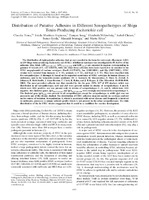Please use this identifier to cite or link to this item:
http://sgc.anlis.gob.ar/handle/123456789/274| Title: | Distribution of putative adhesins in different seropathotypes of Shiga toxin-producing Escherichia coli | Authors: | Toma, Claudia Martínez Espinosa, Estela Song, Tianyan Miliwebsky, Elizabeth Chinen, Isabel Iyoda, Sunao Iwanaga, Masaaki Rivas, Marta |
Keywords: | Escherichia coli O157;Adhesinas de Escherichia coli;Infecciones por Escherichia coli;Microbiología de Alimentos;Toxinas Shiga;Serotipificación;Humanos;Animales | Issue Date: | 2004 | Description: | The distribution of eight putative adhesins that are not encoded in the locus for enterocyte effacement (LEE) in 139 Shiga toxin-producing Escherichia coli (STEC) of different serotypes was investigated by PCR. Five of the adhesins (Iha, Efa1, LPFO157/OI-141, LPFO157/OI-154, and LPFO113) are encoded in regions corresponding to genomic O islands of E. coli EDL933, while the other three adhesins have been reported to be encoded in the STEC megaplasmid of various serotypes (ToxB [O157:H7], Saa [O113:H21], and Sfp [O157:NM]). STEC strains were isolated from humans (n 54), animals (n 52), and food (n 33). They were classified into five seropathotypes (A through E) based on the reported occurrence of STEC serotypes in human disease, in outbreaks, and in the hemolytic-uremic syndrome (M. A. Karmali, M. Mascarenhas, S. Shen, K. Ziebell, S. Johnson, R. Reid-Smith, J. Isaac-Renton, C. Clark, K. Rahn, and J. B. Kaper, J. Clin. Microbiol. 41:4930-4940, 2003). The most prevalent adhesin was that encoded by the iha gene (91%; 127 of 139 strains), which was distributed in all seropathotypes. toxB and efa1 were present mainly in strains of seropathotypes A and B, which were LEE positive. saa was present only in strains of seropathotypes C, D, and E, which were LEE negative. Two fimbrial genes, lpfAO157/OI-141 and lpfAO157/OI-154, were strongly associated with seropathotype A. The fimbrial gene lpfAO113 was present in all seropathotypes except for seropathotype A, while sfpA was not present in any of the strains studied. The distribution of STEC adhesins depends mainly on serotypes and not on the source of isolation. Seropathotype A, which is associated with severe disease and frequently is involved in outbreaks, possesses a unique adhesin profile which is not present in the other seropathotypes. The wide distribution of iha in STEC strains suggested that it could be a candidate for vaccine development. Fil: Toma, Claudia. University of the Ryukyus. Division of Bacterial Pathogenesis; Japón. Fil: Martínez Espinosa, Estela. ANLIS Dr.C.G.Malbrán. Instituto Nacional de Enfermedades Infecciosas. Servicio de Fisiopatogenia; Argentina. Fil: Song, Tianyan. University of the Ryukyus. Division of Bacterial Pathogenesis; Japón. Fil: Miliwebsky, Elizabeth. ANLIS Dr.C.G.Malbrán. Instituto Nacional de Enfermedades Infecciosas. Servicio de Fisiopatogenia; Argentina. Fil: Chinen, Isabel. ANLIS Dr.C.G.Malbrán. Instituto Nacional de Enfermedades Infecciosas. Servicio de Fisiopatogenia; Argentina. Fil: Iyoda, Sunao. National Institute of Infectious Diseases. Department of Bacteriology; Japón. Fil: Iwanaga, Masaaki. University of the Ryukyus. Division of Bacterial Pathogenesis; Japón. Fil: Rivas, Marta. ANLIS Dr.C.G.Malbrán. Instituto Nacional de Enfermedades Infecciosas. Servicio de Fisiopatogenia; Argentina. |
URI: | http://sgc.anlis.gob.ar/handle/123456789/274 http://jcm.asm.org/content/42/11/4937.full.pdf+html |
ISSN: | 1098-660X | Rights: | info:eu-repo/semantics/openAccess |
| Appears in Collections: | snrd Publicaciones INEI |
Files in This Item:
| File | Description | Size | Format | |
|---|---|---|---|---|
| JournalofClinicalMicrobiology,2004,42(11),4937–4946..pdf | 182.84 kB | Adobe PDF |  View/Open |
Page view(s)
197
checked on Nov 26, 2025
Download(s)
90
checked on Nov 26, 2025
Google ScholarTM
Check
Items in DSpace are protected by copyright, with all rights reserved, unless otherwise indicated.

